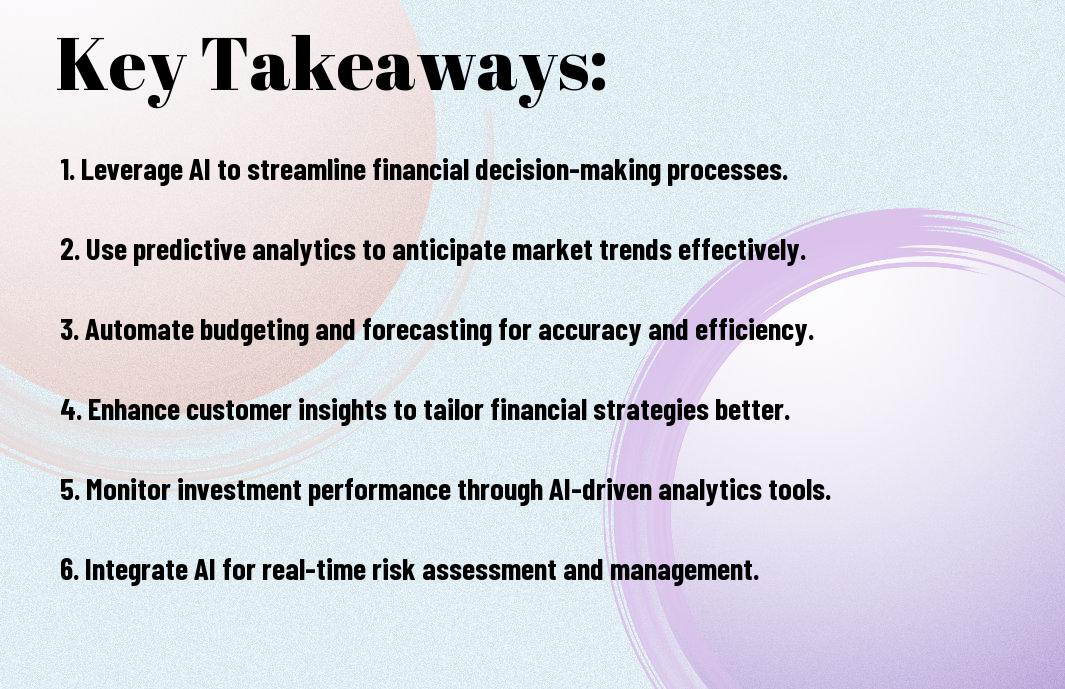As you navigate the ever-evolving landscape of modern entrepreneurship, you’re likely exploring innovative ways to optimize your financial performance. Your business can greatly benefit from leveraging Artificial Intelligence (AI) to streamline operations and boost profitability. By integrating AI into your financial strategies, you can make data-driven decisions, enhance efficiency, and ultimately increase your return on investment (ROI). You will learn how to harness the power of AI to drive your business forward and achieve long-term success.
Key Takeaways:
- Implementing AI solutions can significantly enhance business efficiency and productivity, leading to increased revenue and profitability for modern entrepreneurs.
- AI-driven financial analysis and forecasting enable entrepreneurs to make informed decisions, mitigate risks, and capitalize on emerging opportunities in the market.
- Entrepreneurs can leverage AI-powered tools to automate routine tasks, streamline operations, and allocate resources more effectively, resulting in substantial cost savings.
- By integrating AI into their financial strategies, entrepreneurs can gain a competitive edge, drive innovation, and achieve sustainable growth in today’s fast-paced business landscape.
- Continuous monitoring and evaluation of AI-driven financial strategies are important to ensure alignment with business objectives, identify areas for improvement, and maximize return on investment (ROI) over time.

The AI Investment Landscape
The current state of AI investments is rapidly evolving, and you need to stay informed to make the most of your financial strategies. You will encounter various opportunities and challenges as you navigate this landscape, and it’s crucial to understand the trends and technologies that are shaping the industry.
Current AI Technologies Worth Your Dollar
Amazing advancements in AI have led to the development of innovative technologies that are worth considering for your investment portfolio. You can explore opportunities in natural language processing, computer vision, and machine learning, which are transforming industries and creating new business models.
Risk Assessment in AI Investments
Assessing the risks associated with AI investments is vital to ensuring the success of your financial strategies. You must evaluate the potential downsides of investing in AI, including regulatory challenges, data privacy concerns, and the potential for job displacement.
Hence, as you examine into the world of AI investments, you will need to carefully consider these risks and develop strategies to mitigate them. You can do this by conducting thorough research, diversifying your portfolio, and staying up-to-date with the latest developments in the field, allowing you to make informed decisions and maximize your returns.
Cost-Benefit Analysis of AI Integration
It is vital to evaluate the cost-benefit analysis of AI integration, as you consider implementing AI solutions in your business. You can learn more about maximizing efficiency and ROI in AI initiatives by visiting Maximizing Efficiency and ROI in AI Initiatives: A Guide to Cost Optimization to make informed decisions.
Initial Implementation Costs
CostEffectively, you will need to assess the initial investment required for AI integration, including hardware, software, and personnel costs, to determine the potential return on investment for your business.
Long-term Value Creation
Costs associated with AI integration can be offset by long-term value creation, as you experience increased efficiency and productivity in your operations, leading to improved profitability and competitiveness.
This long-term value creation can be achieved through various means, such as automation of repetitive tasks, enhanced customer experience, and data-driven decision making, allowing you to stay ahead of the competition and drive business growth, as you continue to leverage AI technologies to optimize your operations and improve your bottom line.
AI-Driven Financial Decision Making
Now that you’re exploring the potential of AI in finance, you’ll discover how it can revolutionize your decision-making process, enabling you to make data-driven choices that maximize your ROI.
Algorithmic Trading and Portfolio Management
Around the clock, AI-powered systems can monitor market trends, allowing you to optimize your trading strategies and manage your portfolio with precision, giving you a competitive edge in the market.
Predictive Analytics for Cash Flow
Trading on insights from predictive analytics, you can forecast your cash flow with greater accuracy, enabling you to make informed decisions about investments, funding, and resource allocation, ultimately driving your business forward.
The predictive analytics for cash flow subsection is particularly significant for your business, as it allows you to anticipate and prepare for fluctuations in your cash flow, ensuring that you have sufficient liquidity to meet your financial obligations and capitalize on new opportunities, thereby minimizing risk and maximizing your ROI, you can leverage AI-driven predictive models to analyze historical data, seasonal trends, and market conditions, providing you with a comprehensive view of your cash flow and enabling you to make strategic decisions that drive growth and profitability.
Scaling Operations Through Automation
To maximize your ROI, you need to streamline your operations, and automation is key. By leveraging AI, you can optimize your workflows, increase efficiency, and reduce costs.
Reducing Overhead with Smart Systems
One of the most significant benefits of automation is the ability to reduce overhead costs. You can implement smart systems that minimize manual labor, freeing up resources for more strategic initiatives.
Quality Control and Error Reduction
Below the surface of automation lies a powerful tool for quality control and error reduction. You can use AI to monitor and analyze your operations, identifying areas for improvement and optimizing your processes.
Reduction of errors is a significant advantage of automation, as you can use machine learning algorithms to detect and correct mistakes in real-time. By implementing these systems, you can improve the overall quality of your operations, reduce waste, and increase customer satisfaction, ultimately driving your business forward and maximizing your ROI.

Customer Acquisition and Retention
Unlike traditional methods, AI-powered strategies can help you optimize your customer acquisition and retention efforts, leading to significant returns on investment.
Personalization Engines and ROI
Around 80% of customers are more likely to engage with your brand if you offer personalized experiences, which can be achieved through AI-driven personalization engines, increasing your ROI.
Behavioral Prediction Models
Along with personalization, behavioral prediction models can help you anticipate customer needs, enabling you to tailor your marketing efforts and improve customer retention, ultimately boosting your bottom line.
Even with the complexity of implementing behavioral prediction models, you can leverage AI to analyze customer data, identify patterns, and make informed decisions to drive your business forward, resulting in increased customer loyalty and revenue growth, allowing you to maximize your ROI and stay ahead of the competition.
Measuring AI Performance
Many entrepreneurs struggle to evaluate the effectiveness of their AI investments, but it’s crucial to track performance to maximize ROI. You need to assess your AI systems’ impact on your business, identifying areas of improvement and optimizing your strategy accordingly. By doing so, you’ll be able to make data-driven decisions and drive growth.
Key Performance Indicators
After implementing AI solutions, you’ll need to establish relevant metrics to measure their success. You should focus on indicators that align with your business goals, such as revenue growth, customer engagement, or operational efficiency, to assess the effectiveness of your AI investments.
Adjusting Strategy Based on Data
The key to maximizing ROI with AI is to continuously monitor and adjust your strategy based on data insights. You should analyze the performance of your AI systems, identifying areas of strength and weakness, and make adjustments to optimize your approach and achieve better outcomes.
This process of adjusting your strategy based on data involves regularly reviewing your key performance indicators, analyzing the results, and making informed decisions to refine your AI investments. You can refine your approach by allocating more resources to high-performing areas, addressing weaknesses, and exploring new opportunities to drive growth and improve efficiency, ultimately leading to increased ROI and business success.
Final Words
Following this guide, you will be equipped to maximize your ROI with AI-driven financial strategies. You can now leverage AI to optimize your investments, streamline operations, and make data-driven decisions. By implementing these modern techniques, you will enhance your business’s financial performance and stay competitive in the market. Your ability to adapt and innovate with AI will drive your success as a modern entrepreneur, enabling you to achieve your financial goals and grow your business effectively.
FAQ
Q: What are the key benefits of leveraging AI in financial strategies for maximizing ROI?
A: Leveraging AI in financial strategies can bring numerous benefits, including enhanced predictive analytics, automated decision-making, and optimized resource allocation. By utilizing machine learning algorithms and natural language processing, entrepreneurs can gain valuable insights into market trends, customer behavior, and financial performance, ultimately leading to data-driven decisions that drive business growth and maximize ROI. Additionally, AI-powered financial tools can help streamline financial operations, reduce costs, and improve overall efficiency, allowing entrepreneurs to focus on high-level strategic planning and innovation.
Q: How can entrepreneurs effectively integrate AI into their existing financial planning and analysis processes?
A: To effectively integrate AI into existing financial planning and analysis processes, entrepreneurs should start by identifying areas where AI can add the most value, such as forecasting, budgeting, or risk management. Next, they should invest in AI-powered financial tools and platforms that can seamlessly integrate with their current systems and workflows. It’s also imperative to develop a robust data infrastructure to support AI-driven financial analysis, including data collection, storage, and governance. Furthermore, entrepreneurs should prioritize ongoing education and training to ensure their teams have the necessary skills to effectively work with AI technologies and interpret their outputs, making informed decisions that drive business success.
Q: What are some common pitfalls or challenges that entrepreneurs should be aware of when using AI to maximize ROI in their financial strategies?
A: When using AI to maximize ROI in financial strategies, entrepreneurs should be aware of several common pitfalls, including data quality issues, algorithmic bias, and overreliance on automation. Poor data quality can lead to inaccurate predictions and flawed decision-making, while algorithmic bias can result in unfair or discriminatory outcomes. Additionally, overreliance on automation can lead to a lack of human oversight and judgment, potentially resulting in missed opportunities or unforeseen consequences. To mitigate these risks, entrepreneurs should prioritize data quality and integrity, regularly audit and test AI systems, and maintain a balanced approach that combines the benefits of AI with human expertise and judgment, ensuring that AI is used as a tool to augment and support, rather than replace, human decision-making.



